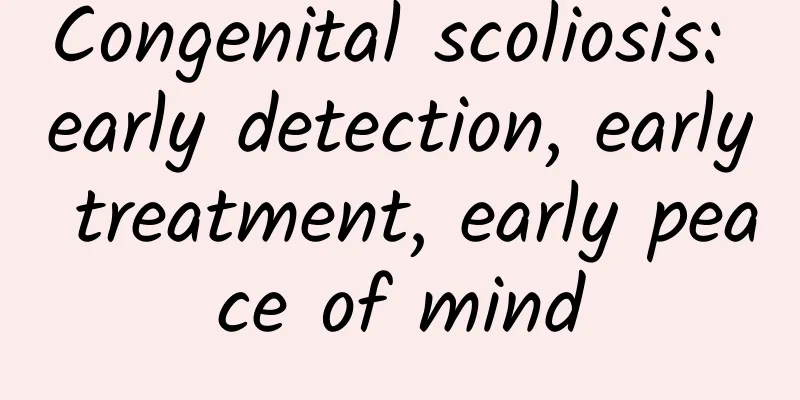Congenital scoliosis: early detection, early treatment, early peace of mind

|
Author: Shen Jianxiong, Chief Physician, Peking Union Medical College Hospital Reviewer: Zhang Zhihai, Chief Physician, Guang'anmen Hospital, China Academy of Chinese Medical Sciences The spine is not only an important supporting structure of the human body, but also bears the responsibility of protecting the central nervous system. However, for some children, their spines face a challenge different from ordinary people since birth - congenital scoliosis. This disease not only affects the patient's appearance, but also may pose a potential threat to the heart, lung function and other organs. Congenital scoliosis is a structural abnormality of the spine that develops early in fetal development, resulting in a curvature or kyphosis of the spine. This abnormality usually occurs between the 4th and 6th weeks of pregnancy, when the fetus is undergoing a period of rapid development. Over time, the deformity of the spine becomes more pronounced, especially as the child grows. Although such abnormalities can occur in any part of the spine, in clinical practice, the thoracic and lumbar spine are the most commonly affected areas, which may be related to the large number of vertebrae in these areas. Figure 1 Original copyright image, no permission to reprint The specific cause of congenital scoliosis is not yet fully understood, but studies have shown that environmental factors and genetic factors may be the main cause. Environmental factors include maternal hypoxia, carbon monoxide poisoning, and air pollution; genetic factors involve specific gene mutations, such as TBX6 gene mutations, which are closely related to spinal development. In addition, vitamin A deficiency has also been shown to be related to the occurrence of congenital scoliosis. The harm of congenital scoliosis is not only a cosmetic defect, but it may also have a long-term impact on the patient's cardiopulmonary function and quality of life. Spinal deformity can lead to limited chest development, which in turn affects respiratory function. In some cases, this deformity may also affect the heart and increase the risk of heart abnormalities. In addition, about 15%-20% of patients may have urinary system deformities. Early identification is crucial for the management of congenital scoliosis. At present, advances in prenatal examination technology have made it possible to detect abnormalities in the fetal spine through ultrasound or magnetic resonance imaging around 20 weeks of pregnancy. Once congenital scoliosis is discovered, although prenatal intervention methods are limited, parents can be prepared and seek professional advice immediately after the child is born. After birth, parents can initially determine whether scoliosis exists by observing whether the child's back is symmetrical and whether the shoulder height is consistent. In some cases, hair on the back, birthmarks or dimples may also be one of the signs of congenital scoliosis. If you suspect that your child has congenital scoliosis, the most direct way is to go to the hospital for an X-ray to confirm the diagnosis. Further examinations may include CT scans and MRIs to assess the degree of spinal deformity and whether there are abnormalities in the spinal canal. Figure 2 Original copyright image, no permission to reprint The strategy for managing congenital scoliosis depends on the type, location, and severity of the deformity. For simpler deformities, such as a single hemivertebra, treatment is usually straightforward and effective. More complex deformities, such as those involving the ribs or rib cage, may require more complex treatments, sometimes even until the child is older. It is worth noting that untreated congenital scoliosis tends to worsen over time. According to literature, about 50% of patients with congenital scoliosis eventually require surgical intervention. Therefore, early diagnosis and regular monitoring are essential to prevent the condition from worsening. For parents, understanding the relevant knowledge of congenital scoliosis can better support their children in coping with this challenge and take appropriate treatment measures. |
<<: Congenital Scoliosis: When to be conservative? When to be surgical?
>>: How to recover and live after surgery for congenital scoliosis?
Recommend
How long does it take for the milk to go down?
As we all know, breastfeeding is the healthiest, ...
Breast cancer gene testing
The famous movie star Angelina Jolie underwent a ...
What causes lactation urticaria?
In fact, rubella infection is not only common in ...
The little girl lives alone for a long time and "only eats white rice". Is white rice not nutritious?
A fourth-grade girl in Luoyuan County, Fuzhou Cit...
Why do girls have cold hands and feet? Because this place is more developed than boys
When winter comes, do you feel your hands and fee...
What are the benefits and functions of garlic sprouts? How to eat garlic sprouts
Garlic sprouts, also known as garlic hairs, are t...
Is it better to add salt to fish before or after stewing? When is the best time to add salt to fish?
We all know that fish is a popular food. It is ri...
What causes a woman's face to turn dark and yellow?
After a woman reaches the age of 30, her physical...
How to prevent skin aging after the age of 25? Eight aspects to pay attention to
Aging is what people least want to see, so now pe...
What to eat when pregnant women are malnourished
Many pregnant women will pay attention to their w...
Can I get pregnant if my hymen is not broken?
In medicine, rupture of the hymen refers to the r...
The first and second babies react differently. Are the genders the same?
Many women will have a certain degree of pregnanc...
Can I drink laxative tea during menstruation?
In recent years, the sales of laxative tea have b...
What causes menstrual disorders?
Nowadays, more and more women are suffering from ...
Is lacunar infarction a small cerebral infarction? What should I do?
An old man told Huazi that during a brain CT scan...









